Prologue:
When my mother died a little over two years ago, she left explicit instructions for how her daughters were to spread her ashes in her birthplace of Rome, Georgia. Earlier in the year, October 7- 8 had been chosen as the weekend we’d all travel to Georgia to fulfill her wishes. For multiple reasons that trip did not come together, yet it remained on my calendar, beckoning.
I had known for some time that there was a graveyard in western Maryland where my father’s ancestors were buried. One of my cousins had recently visited the ancestral burying grounds, along with two churches and a house built by our forbears. She’d emailed directions to these sites as well as some accompanying historical documents she’d found on the web.
On Sunday, October 1, I ran into a friend whose husband had recently passed away. We had a long conversation about the power of the rituals of remembrance we perform after our loved ones leave us. During that conversation, I remembered that the following weekend was intended for just such a ceremony.
Feeling the need to do something spiritually significant, the next day I texted my sister Joan, who lives in Maryland. “Are you free next weekend? I have exact directions to where the Protzman ancestors are buried and where the old homeplace was. If we can’t spread Fran we can take Blair back to be with his homies.”
“Sounds good,” she texted back. I began to pack my bags.
As the weekend drew closer, more and more of my attention was pulled toward the journey ahead. I downloaded the documents my cousin had sent and decided to go up a day early so we could have a full day exploring on Saturday.
Late Friday afternoon on October 6, I arrived at the Days Inn in Westminster, MD, a half-mile down the road from the apartment where my mother spent the last few years of her life. Once settled into my hotel room, I pulled out my cousin’s documents. This was when I first read:
“On the next day, Sunday, October 8, 1758, the solemn services appropriate to the organization were held, and Bishop Hehl declared this little flock to be a congregation in regular connection with the Church of the Moravian United Brethren.”
Three of my ancestors, two men and a woman, were listed among the attendees at this event, in which my 4x great grandfather, Lorenz Protzman, who’d arrived in this country some years earlier from Germany, was elected a Steward of the congregation. Interesting coincidence, I thought: we’d be visiting the graveyard the day before the 259th anniversary of the church’s founding.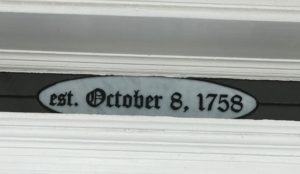
The next morning Joan and I headed west through the rolling farmlands of Maryland on State Route 77. Thirty minutes later we pulled into the parking lot of Graceham Moravian Church. Noticing several cars in the lot, I began to search for an unlocked door while Joan wandered the grounds. The third door I tried opened. I descended into a huge basement kitchen full of women making sheetpans full of what looked like Christmas cookies. They looked up from their work, surprised.
“Hi! My name is Leslie Protzman, and my ancestors were founders of this church. My sister and I are visiting . . . “
“Pastor Sue!” someone called. A diminutive woman in a headscarf began walking toward us as she took off her apron. Someone else called out, “Protzman? Did you say Protzman? I live in the Widow Protzman’s house!”
I ran outside and yelled, “Joan, get in here!”
Pastor Sue greeted us warmly, saying there was someone who knew a lot about church history who could be here in about twenty minutes if we didn’t mind waiting. The woman who’d said she lived in Widow Protzman’s house was already taking off her apron and asking if we’d like to see the house. “I can’t take you inside, because I have a dog that would bite you, but we can walk around outside.”
My heart was beating so fast, I felt giddy. The three of us walked from the parking lot up a short hill. “This was the third house in this community – the first two burned down. I’ve always heard it referred to as the Widow Protzman’s house,” said the woman we now knew as Joanne. Joanne walked us around her house, showing us the outlines of the original log cabin, which occupied only a small portion of the overall structure. She’d lived here since the 1970’s: she and her husband had raised a family here. We wandered around the property as Joanne showed us where the barn had been, how deep the plot was. We felt like we’d entered a portal to another realm.
Back at the church, Joanne continued with a tour of its interior, which had been built in 1822 over the site of the original building. We marveled at the beautiful arc of the ceiling, the well-tended floors burnished by thousands of footsteps, the overall sense of simplicity and tender care. Then Joanne went back to making peanut butter balls while Pastor Sue introduced us to Mike Miller, the church historian. Mike escorted us to a big table in the “Heritage Room,” which contained the altar from the original church and other church relics, and began laying out maps and books.
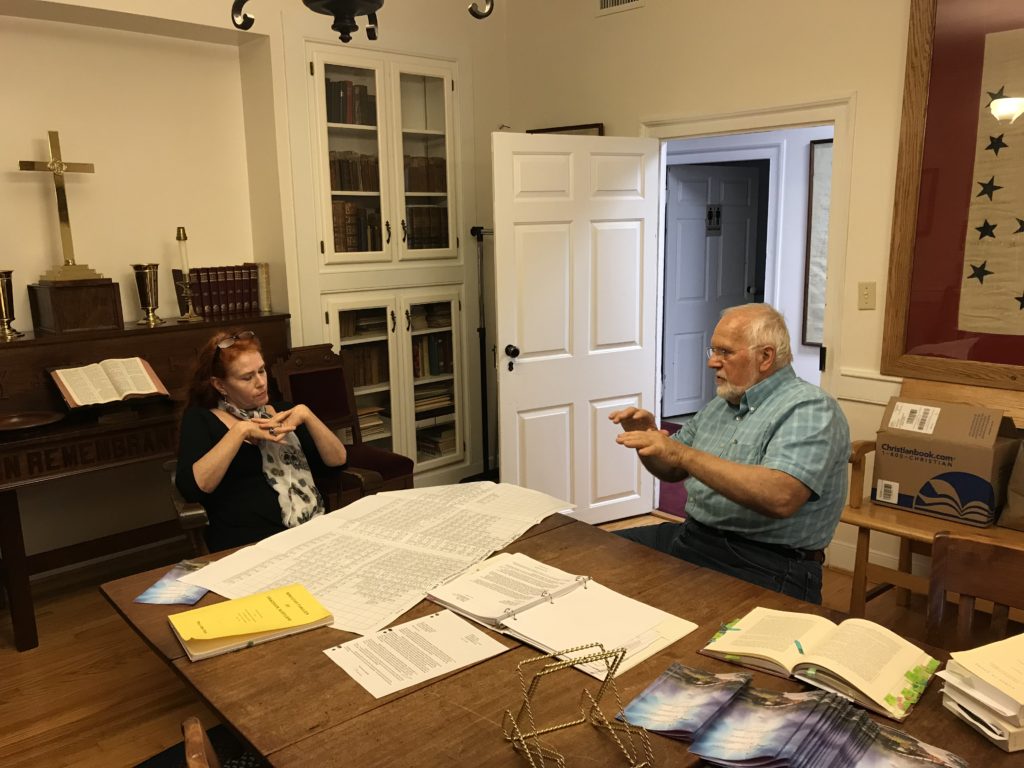 I truly don’t know how long we sat at that table. An incredibly kind and knowledgeable guide, Mike brought out a book titled the “Moravian Families of Graceham, Maryland, 1750 – 1871” and we found three pages of Protzmans, their births and deaths lovingly noted:
I truly don’t know how long we sat at that table. An incredibly kind and knowledgeable guide, Mike brought out a book titled the “Moravian Families of Graceham, Maryland, 1750 – 1871” and we found three pages of Protzmans, their births and deaths lovingly noted:
“John Henry, born F 4, 1785 at 5 – 6 pm. baptized F 13, 1785; died F 13, 1786 of injuries caused by a hard fall on the head; buried in the churchyard F 14, 1786.“
He told us that the Moravians were consummate record keepers, that their pastors kept detailed accounts of births and deaths in real time. Even children born of illegitimate unions were noted:
“PROTZMAN, Margarethe had by John (name blotted), in the mountains, an illegitimate son John Jacob (1:217) who was born Mr 10, 1815 and baptized Apr 23, 1815.”
There were a fair number of illegitimate children: 18th century Protzmans seemed to be a randy bunch. We marveled that in the eighteenth century, these children were acknowledged by their community and baptized. Recognized and enfolded into the congregation.
Mike showed us a map of the church’s cemetery, compiled by another Protzman relative (unknown to us), who had passed through some ten years earlier also searching for relatives. Protzmans were scattered throughout. He explained that Moravian graves had originally been laid out “choir style,” women on one side, men on the other, children in yet another, all marked with “flat” stones. We later learned that flatstone cemeteries were an expression of the Moravian value of egalitarianism – all the stones were of the same shape and relative size, so no one was “higher” than another; the layout of the cemetery continued the shape of the congregation in life.
Mike walked us through the church again, this time more slowly, as we absorbed the sense of love reflected in this building. “Lovefeasts, they are wonderful!” Mike beamed, as he showed us the cabinet where mugs for coffee and buns were stored for the church celebrations. Moving toward the central sanctuary, he opened a closet where handmade candles were stored, lovingly crafted from beeswax and decorated by members of the congregation –– and told us to pick one out for ourselves. The feeling of connection was palpable.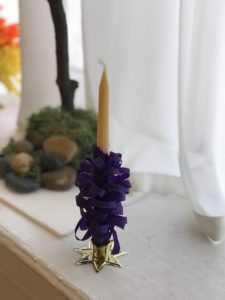
After saying goodbye to Pastor Sue and the ladies in the kitchen, we drove across the road, up the hill and over the railroad tracks to the cemetery, situated on a knoll with a 360-degree view that included the church on one side and the Appalachian foothills on the other. Mike accompanied us for a bit as we wandered through the stones looking for ancestors, then graciously left us to our own devices.
This was ground zero for the paternal side of our family in this country. Under the shelter of a few trees at the eastern edge of the cemetery, we spread a blanket on the ground and set up a makeshift altar to our father.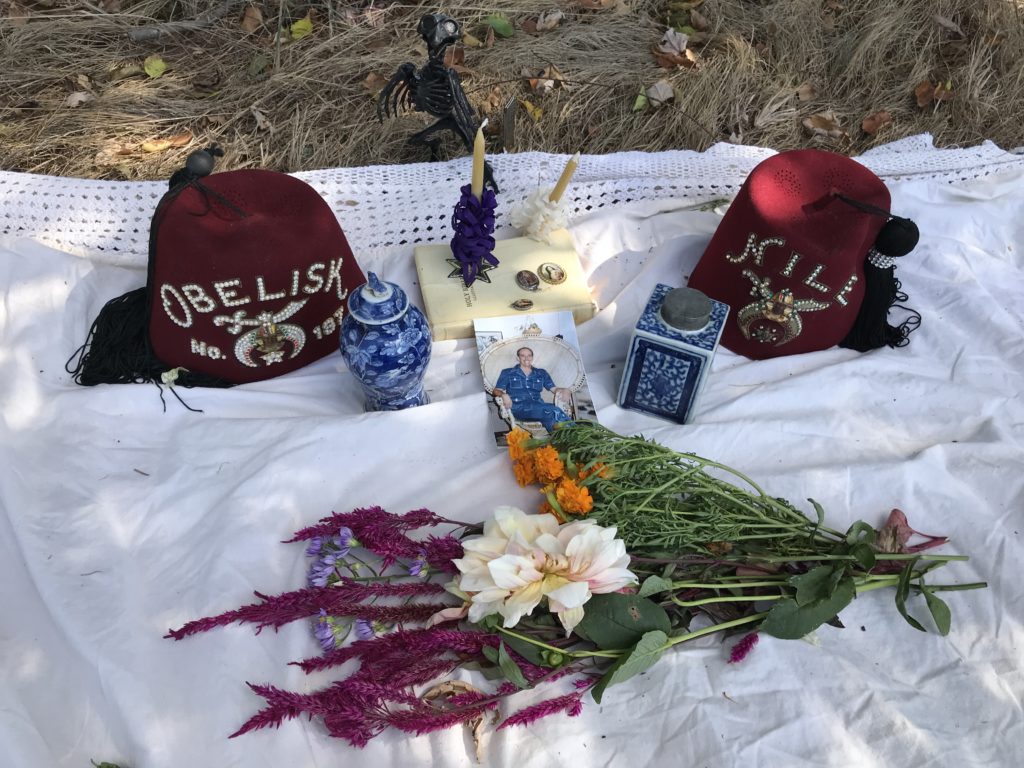
The breeze was soft, the sun was shining, and our feet were walking the same paths our ancestors walked as they mourned their own lost loved ones over two centuries earlier. Every stone indicated not only the date of birth and death, but also the number of years, months and days lived by its occupant, even the many young ones who were born and died on the same day. I remarked on how amazingly detailed this seemed.
“Yes,” said Joan. “Every day was precious to them.”
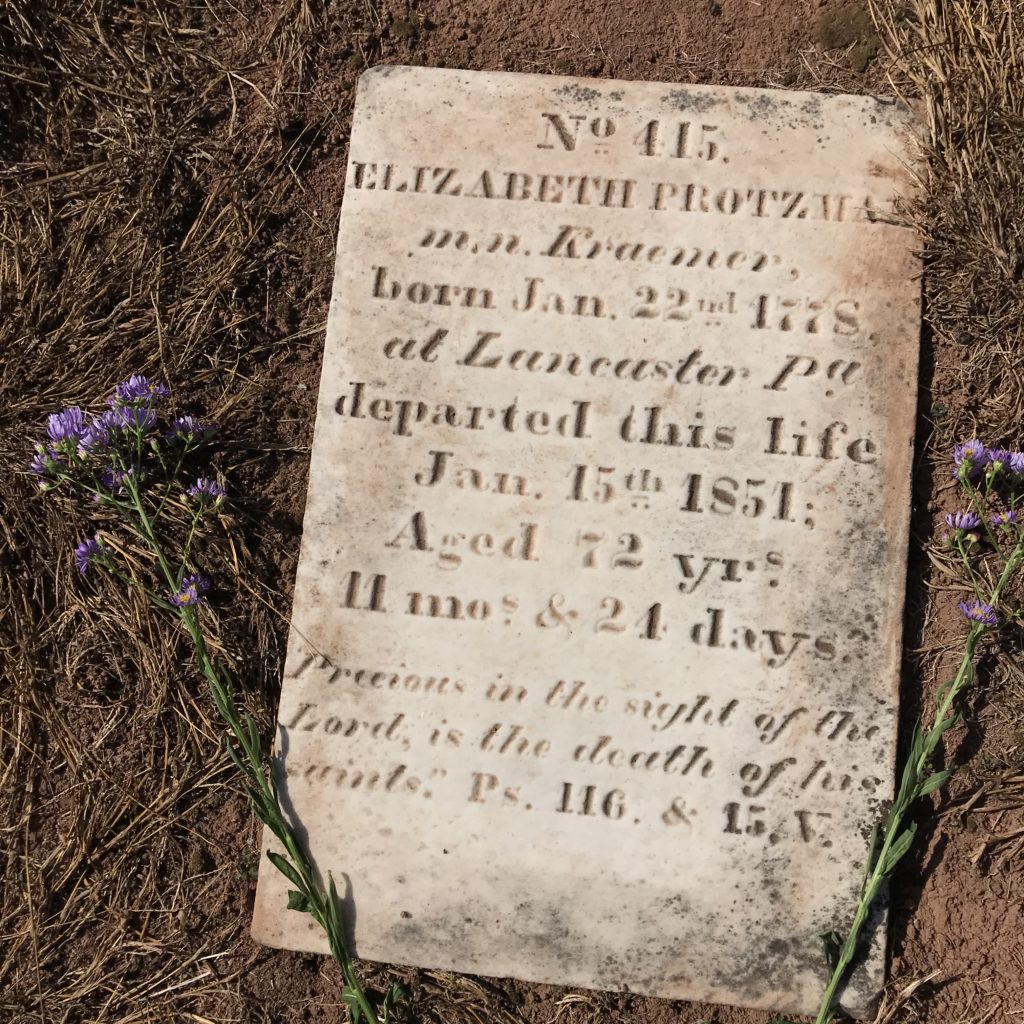 We marked the Protzman graves with flowers, recalling memories of our father and stories we’d heard about our relatives. Wandering the rows, we realized that given the small number of inhabitants of early Graceham, we were probably related to most of the people in this graveyard. The hours flew by, each one deepening our sense of connection.
We marked the Protzman graves with flowers, recalling memories of our father and stories we’d heard about our relatives. Wandering the rows, we realized that given the small number of inhabitants of early Graceham, we were probably related to most of the people in this graveyard. The hours flew by, each one deepening our sense of connection.
After a love feast of our own consisting of exquisite cheese Danish we’d brought from the JeannieBird bakery in Westminster, we pulled up camp and headed over the mountain toward a second church and cemetery. We found Beard’s Church, then spied a cemetery off in the distance. Here we paid our respects to ancestors marked by upright stones that were nearly indecipherable.
Just down the road from Beard’s church, we found the stone house that my cousin’s notes, pulled from an on-line article, indicated had been built by a second generation of Protzmans around 1812.
My cousin had mentioned another location where the original Beard’s church had stood, so we set off again and soon found the intersection that marked the spot. Her notes indicated that she’d traveled up what appeared to be a private drive to find a cemetery. So we shrugged our shoulders and drove up a dirt road across from the now vanished church, behind a big McMansion where men were digging with earthmovers. Encountering a “No Trespassing” sign at the top of the hill, we turned around. As we reached the main road, a shirtless young man ran down the hill frantically waving his arms and shouted “My boss wants to know what you’re doing up there!”
“We thought there might be a cemetery up there where our ancestors are buried,” we said as we rolled down the window. The young man signaled to his boss that we were cool, then the boss walked down the hill to talk to us. “We’ve got a heroin epidemic out here,” he said. “I’ve had kids go up that road to shoot up, so I’m always on the alert.”
“We’re not heroin addicts,” I said, laughing. “We’re just old people looking for dead people.”
We asked whether he’d heard of the name Protzman or knew of any nearby cemeteries. He scratched his head, then his face lit up. “I know! Pat Schooley! She knows everything about the history around here. She’s the lady in the big stone house up the road, with the peacocks and the guinea hens. Damn guinea hens – they make so much noise1 Go see her – she’ll know what you’re looking for.”
A few minutes later we pulled into a long empty driveway to an iron gate and an intercom. I got out of the car and pushed the button. A Great Pyrenees dog came bounding down the hill, but no one emerged from the great stone house. (Synchronicity alert – the last dog my father owned was a Great Pyrenees).
I started to get back into the car just as someone came out onto the porch and began waving her arms. “Open the gate outwards!” she shouted, and signaled us to come up.
And so we were welcomed into yet another stranger’s presence. My sister told her we were looking for Protzmans, and began quoting the information from my cousin’s email about the Protzman homestead.
“I wrote that article,” she said, inviting us to sit down in her living room. She reached into a cupboard and pulled out a coffee table sized book. “It’s in this book.”
Pat Schooley graciously spent over an hour with us talking about local history, followed by a tour of her home, which was built in the 17th century, and lovingly renovated over her thirty plus years in it. She also sold us a copy of her book, Architectural and Historic Treasures of Washington County, Maryland, written in collaboration with the Washington County Historical Trust. “You just wait for innocent passersby to roll up your driveway and ring your doorbell so you can sell them a book,” we joked as we left.
By that time, it was about 5:30 in afternoon. Hungry and dazed by all the emotional, intellectual, physical, and energetic information we’d taken in during the course of the day, we headed fifteen miles down the road to Frederick Maryland for dinner and a good night’s rest.
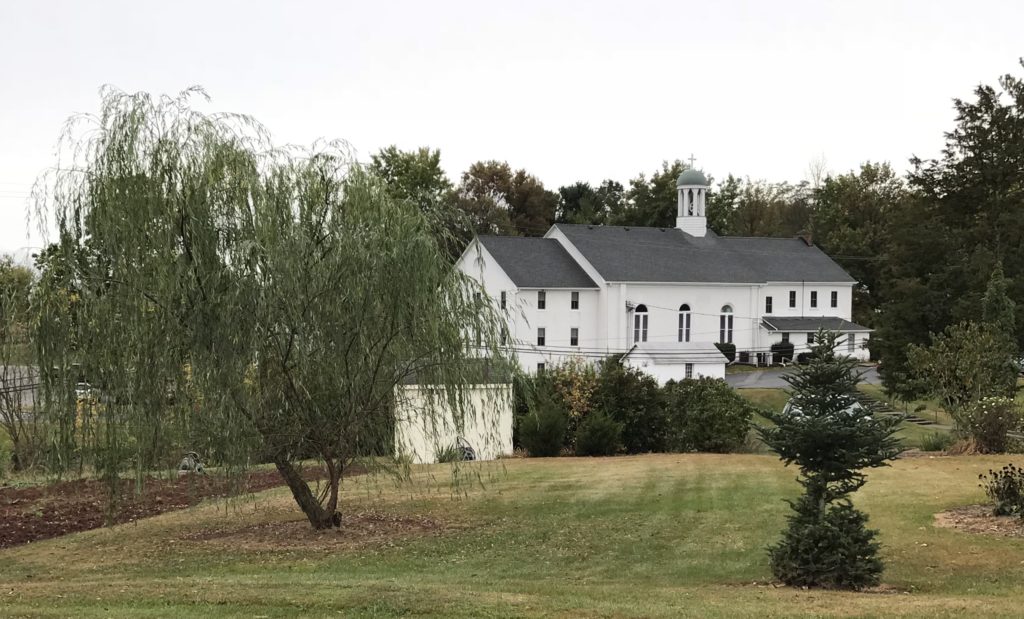 The next morning we returned to Graceham Moravian Church to attend service on the 259th anniversary of its founding. We were welcomed warmly by the members of this small congregation. Pastor Sue introduced us three times during the service, which included a “Prayer of Intercession in a Time of Crisis,” recited in call and response. These words stood out for me:
The next morning we returned to Graceham Moravian Church to attend service on the 259th anniversary of its founding. We were welcomed warmly by the members of this small congregation. Pastor Sue introduced us three times during the service, which included a “Prayer of Intercession in a Time of Crisis,” recited in call and response. These words stood out for me:
“Where indifference allows crisis to deepen and suffering to go without relief, awaken deliverers who have zeal and strength.”
“We pray for those who are engaged in making important decisions in this time, for those who report on these events, and for those who shape public opinion. Give them the courage to speak out and the restraint to listen, that together we may discern the truth and hold aloft its light.”
“Take away the temptation to trust in human power and military solution, and give us the courage to be your servants to the community of nations. Direct all governments in the ways of peace and justice, that your will may be known and done among the nations. Deliver us from the sins which lead to war and conflict, and strengthen within us the will to establish righteousness and justice on the earth.”
“I don’t think we’re in Trump country,” I whispered to Joan. (Once back in Richmond, I learned that Pastor Sue was present in Charlottesville on August 12, as part of an interdenominational delegation offering peaceful, inclusive witness to the horrific events of that day. That on August 15 the Moravian Church in America had made a statement explicitly condemning white supremacy, while acknowledging its own complicity “in perpetuating this sin, both now and in our history.” This was not the first time they’d condemned racism – the Church had made a previous Statement on Racism in 1998.)
After saying our goodbyes, my sister and I drove across the road to spend more time in the cemetery. The heavy rains that had been predicted held off, and we ambled the pathways in a soft grey mist, each step deepening our connection to this place. Again time stood still.
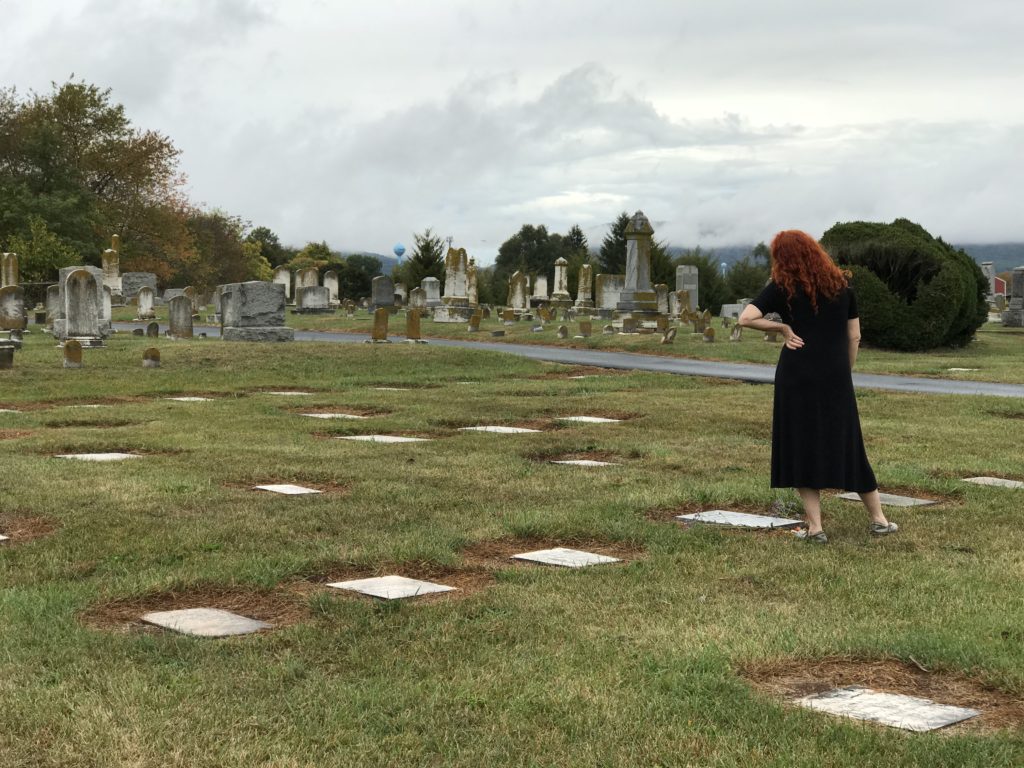 Throughout this whole weekend, I felt like we were being held in the hand of grace, that we had been transported into some spirit realm. Our ancestors were lovingly welcoming us home through the physical presence of the people of the congregation and the carved stones of the graveyard. Having had some exposure to the concepts of intergenerational trauma and resilience, I felt a profound sense of healing, as if huge forces were coming into alignment. There was a deep sense of belonging, of coming home.
Throughout this whole weekend, I felt like we were being held in the hand of grace, that we had been transported into some spirit realm. Our ancestors were lovingly welcoming us home through the physical presence of the people of the congregation and the carved stones of the graveyard. Having had some exposure to the concepts of intergenerational trauma and resilience, I felt a profound sense of healing, as if huge forces were coming into alignment. There was a deep sense of belonging, of coming home.
The contemporary Protzmans I know are an open-minded, curious, well-traveled bunch who embody what I am learning are core characteristics of the Moravian faith (simplicity, happiness, un-intrusiveness, fellowship, and the ideal of service). I can see this legacy going back through the couple of generations with whom I’ve had direct contact. Even though we lost the Moravian religion somewhere along the way, these ancestral values still resonate within current generations of Protzman folk. Plus now we had proof that we can legitimately call ourselves Bohemians (The original Moravians fled religious persecution in Moravia and Bohemia. It cracks me up that my family has always jokingly referred to ourselves as Bohemians and now we know that’s because we ARE Bohemians.)
Back in Richmond on Monday, I shared the story of our weekend with a friend, who marveled at all the “coincidences” in my journey. My friend, who is African-American, rejoiced in my experience of reconnecting with a lost part of my past. But it also evoked sadness in her. Reflecting on the legacy of slavery, she said: “As an African-American, it’s almost impossible to have the kind of experience you just had – very few records were kept during the time of slavery. I know where my great-grandfather is buried, but that is as far back as I can go.”
There is extraordinary power contained within our ancestral burying grounds. Walking out of this experience gives me a visceral sense of why it is so important to support efforts like The Sacred Ground Historical Reclamation Project here in Richmond. The ability to connect with one’s ancestors, to honor the legacy of what’s come before, in all its beauty and brutality, unleashes the possibility of profound healing. I can’t help but think what power might be unlocked in our community if reverence for our shared histories was valued as much or more as commercial development.
As I continue to learn about my Moravian history, I keep finding bits of information that feel like signposts, as if the ancestors are dropping crumbs to create a path in the wilderness. They are teaching me to have faith, to be comfortable with not knowing where this path will lead.
Earlier this fall I’d noticed an announcement going around Facebook for a Community Trust-building Fellowship. Though it resonated deeply, I felt too overwhelmed by the current complexity of my life to apply. A week before my trip to Graceham, I was walking down the street near my house with a friend, and saw a piece of paper on the sidewalk. Picking it up to throw it in the trash, I opened the paper and found . . . an application for the Community Trust-building Fellowship. Even though this was obviously a sign, I still dismissed it, feeling like it was more than I could handle.
After the trip to Graceham, recognizing that my ancestors were smacking me upside the head with a gentle, humorous touch, I applied for the Fellowship. On November 3 I was thrilled to learn that I’d been accepted.
By the time I was twenty-one I’d lived in at least sixteen different communities, then continued my itinerant ways until I landed in Richmond at the age of twenty-seven. Having never had roots in one place has its advantages: I’ve been welcomed into many communities and cultures over the course of my life, and truly feel at home as a child of the earth. I’m adaptable and can set up camp pretty quick. But I’ve also always felt like an outsider – never quite able to root, even in the town where I have now spent over half my life. More than anything, the adventure I had with my sister in Graceham feels like a story of coming home. I have a palpable sense of belonging, of being rooted in a history I didn’t know existed.
Next month, the Graceham Moravian Congregation has invited us to a Lovefeast, part of their traditional cycle of preparing for the Christmas season. We’ve been offered a room in the parsonage in this tiny hamlet, so we’ll be sleeping within shouting distance of where our ancestors first arrived in this new land and decided, “Here is where we’ll stay.”
I can’t wait to go home.
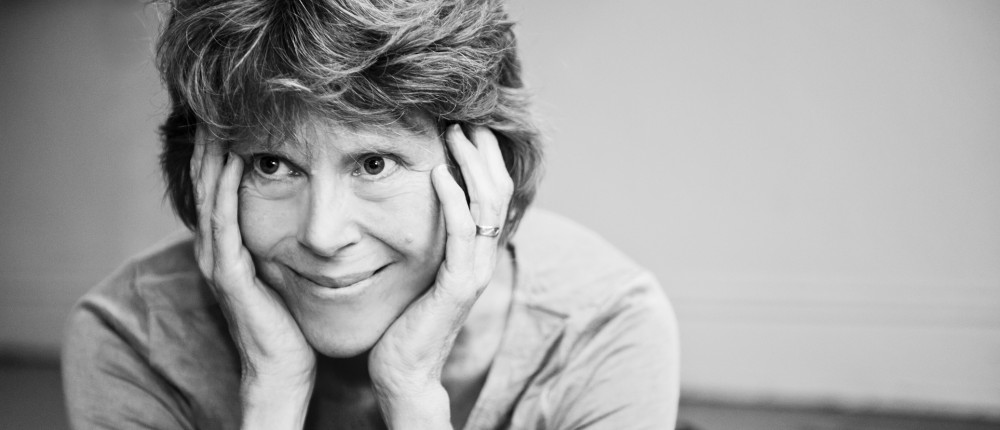
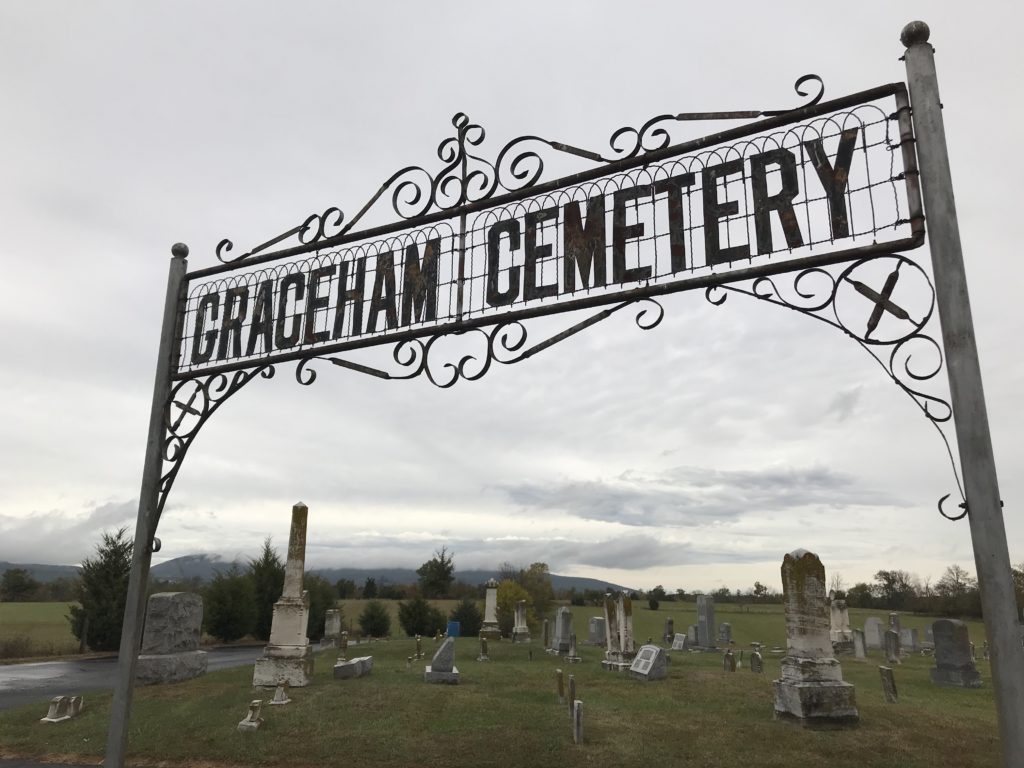
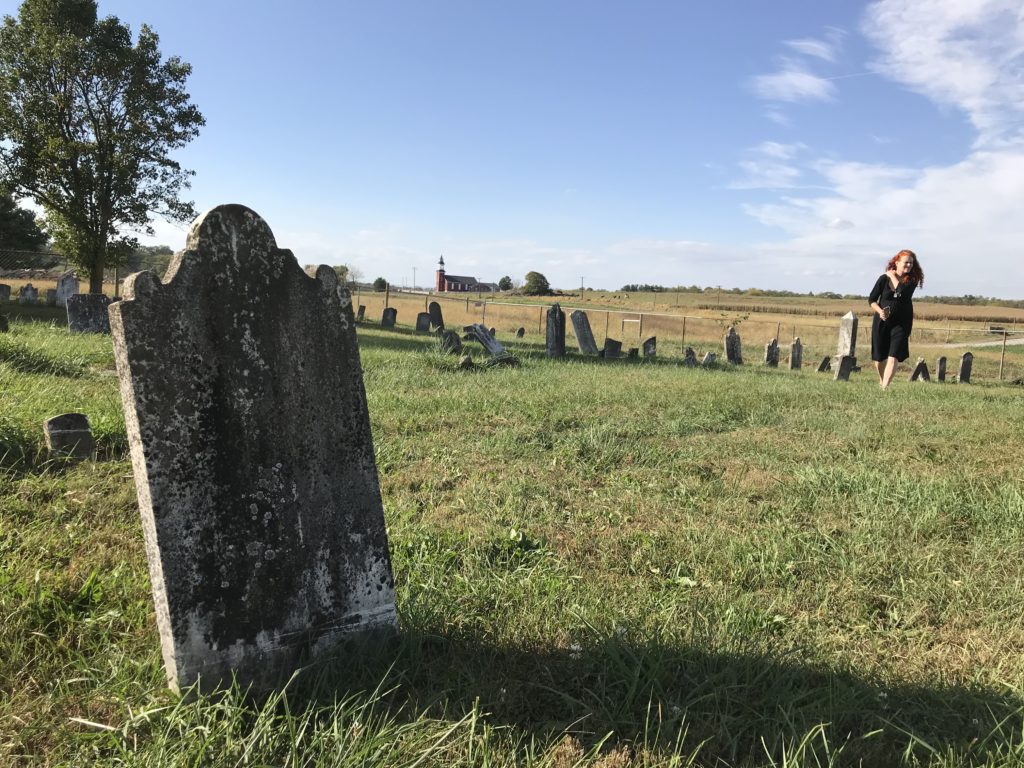
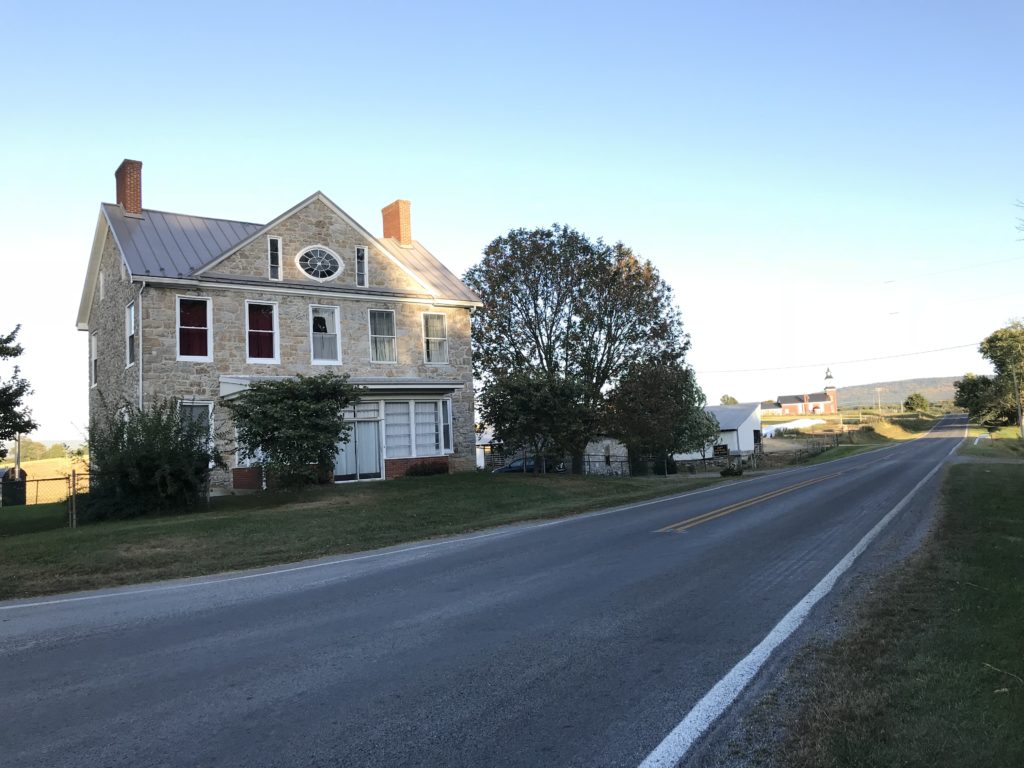
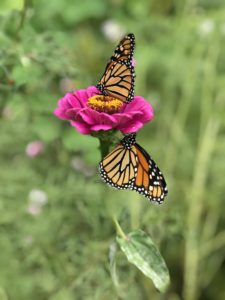

It’s a beautiful story, Leslie. Thank you for sharing with us. I’ve always felt fortunate that my dad has shared his route In Wolf Coal, Kentucky with all of us. As you point out, there’s something special about feeling connected across generations.
I loved reading this! Thank you, Leslie.
Thank you for reading it Diana!